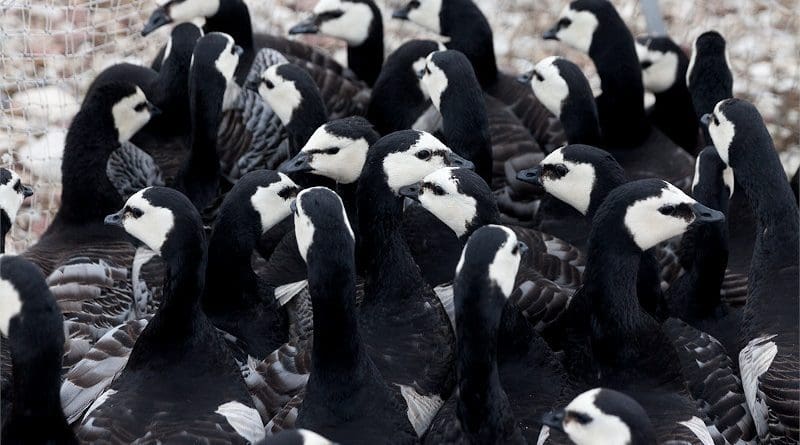Skinnier But Resilient Geese Thriving In High Arctic
The world is changing in dramatic ways, especially in the High Arctic. Climate change has meant that spring arrives earlier, but winters have become far more treacherous for Arctic animals that overwinter there, with more rain and ice.
So what about birds that don’t overwinter in the Arctic, but nest and raise young there? Researchers have spent nearly three decades collecting data on a group of barnacle geese that migrate to the Norwegian archipelago of Svalbard to see how the geese respond to environmental changes overall.
In one study they found that earlier springs linked with climate change meant better conditions for the geese, but that these benefits were cancelled out by an increase in numbers of hungry foxes — a precarious balance that could change depending on future conditions.
Now, researchers have looked at the actual physical condition of the geese as their numbers have skyrocketed at their overwintering grounds in the UK. There are more than 40,000 birds now compared to just 300 individuals in the 1940s, when the birds were still hunted in both UK and elsewhere.
More birds, however, means more competition for food in their summer nesting areas on Svalbard.
There’s so much competition, in fact, that the average body weight of the birds has dropped by 10 per cent in the last three decades. In wild animals, reduced body weight often means reduced condition and a low ability to reproduce or survive. The question the researchers have tried to answer in a new publication is, does this really matter?
The answer, it seems, is no. Not yet.
A long journey to nesting grounds
Kate Layton-Matthews completed her PhD dissertation at NTNU’s Centre for Biodiversity Dynamics on the geese earlier this year. She worked with a team of researchers from NTNU, the University of Groningen in the Netherlands, the University of Sheffield in the UK and the Norwegian Polar Institute in Tromsø on modelling a long-term population study on the barnacle goose.
Barnacle geese breeding on Svalbard make a 3000 km long trip every spring to their Arctic breeding grounds from their overwintering areas in Scotland. That in itself requires a great deal of energy, but the birds also still need to be in good enough condition when they arrive in the Arctic to lay eggs and raise their young.
As the team of researchers looked at their decades of data, they detected the 10 per cent drop in the birds’ body weight.
So Layton-Matthews used a complex statistical model that could digest information on both body condition, reproduction and survival of the geese since 1990. The model allowed her to see if the net effect of lower body weights was actually affecting the ability of the birds to survive and reproduce, and ultimately if this has caused changes in goose population numbers.
Skinnier geese do not cause population decline
“We have this kind of underlying expectation that body condition is so important for herbivores, and especially in the Arctic that your body condition can limit reproduction and probability of survival. So body weight, or body condition, could limit if they manage to have offspring or not, and also whether, especially young geese, survive their first migration,” she said.
Surprisingly, however, although changes in body condition do influence reproduction and survival of young geese somewhat, this did not translate into noticeable effects on population numbers.
“We were expecting that something so important at the individual level would have big impact on the population, but it doesn’t,” she said.
The researchers say this is because it’s overridden by other important environmental effects that don’t affect the geese through body condition, such as the positive impact of earlier springs on gosling production, and the negative effect of Arctic foxes on goslings’ survival.
However, because there is obviously a limit to how skinny the geese can be and still perform well, if their summer habitat continues to degrade, it’s likely to restrict population growth at some point.
The good news, Layton-Matthews said, is that this still shows the geese populations are more resilient to changes in habitat quality and body condition than researchers previously thought.
Potential risk from hunting
The increase in goose numbers in their wintering areas has led to some places, such as Ireland, to allow the birds to be hunted again. It’s also been debated whether barnacle geese hunting should be allowed on Svalbard.
But Layton-Matthews says history has shown that there’s a potential risk if the overwintering birds are hunted too heavily.
“If we start hunting a population that is really sensitive to hunting and quite sensitive to climate change, as we know this population is, we need to be very careful about the hunting levels being set,” she said. “If they’re going to introduce hunting at wintering or breeding grounds, we need to monitor and account for the other processes going on, notably climate change, so that they can set sensible quotas that won’t harm the overall population.”
Maarten J.J.E. Loonen started studying barnacle geese on Svalbard three decades ago to determine how the breeding period would limit population size after the growth in population numbers due to changes on the wintering grounds. Winter populations did well because hunting was banned in Scotland in 1950, and the grasslands where they grazed were fertilized.
“In 1990 we thought that the Arctic would not change and Svalbard, being an island, would result in an increase of competition among the geese and a decrease breeding success,” Loonen said. “In poor years, we knew that gosling growth slowed down and as a consequence these geese became smaller adults. But after thirty years of data collection, this paper shows that there is no effect of declines on population size yet.”

